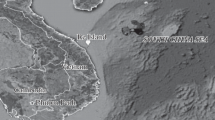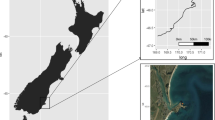Abstract
Studies were performed of the carbon and nitrogen stable isotope (δ13C and δ15N) composition (δ13C and δ15N) of the corals Porites cylindrica and P. lutea (5 years after damaging the colonies by the bleaching events) and of epilithic algae settled onto damaged areas of coral colonies. Coral polyps and three epilithic algal communities (‘red algal turf, green algal turf and red calcified crusts’) were sampled along the boundary between communities of coral polyps and algal colonizers from differently illuminated habitats from 2 to 90% of incident surface photosynthetically active radiation (PAR0). It was found that communities with a predominance of red algae significantly differed from communities with a predominance of green algae in δ13C but not in δ15N values. An influence of habitat irradiance was found only for communities of coral polyps for δ13C and δ15N values: under bright light (70–90% PAR0) polyp tissues of both coral species were significantly enriched in heavy carbon isotopes and insignificantly in nitrogen isotopes (δ13C values difference ~4‰) relative to tissues of corals under lower light 15–50% PAR0. On the basis of these results we assumed that differences in light intensities in the habitat ranging from 15 to 90% PAR0 do not influence on accessibility of the main carbon and nitrogen sources for corals and algae, and exchange by these elements between organisms. We also assumed that the relative enrichment in the heavy carbon isotopes of coral tissues in high light is a result of decreased isotope fractionation (or the absence of fractionation in photosynthesis of their zooxanthellae).
Similar content being viewed by others
References
Diaz-Pulido G, McCook LJ (2002) The fate of bleached corals: patterns and dynamics of algal recruitment. Mar Ecol Prog Ser 232:115–128. doi:10.3354/meps232115
Diaz-Pulido G, McCook L (2003) Top-down and bottom-up processes interact with seaweed recruitment on a coral reef. Ecology 84:2026–2033. doi:10.1890/01-3127
Diaz-Pulido G, McCook L (2004) Algal recruitment on a coral reef: interactions with corals, other benthic organisms, and substrate types. Coral Reefs 23:225–233. doi:10.1007/s00338-004-0370-5
Giordano M, Beardall J, Raven J (2005) CO2 concentrating mechanisms in algae: mechanisms, environmental modulation and evolution. Annu Rev Plant Biol 56:99–131. doi:10.1146/annurev.arplant.56.032604.144052
Heikoop JM, Dunn JJ, Risk MJ, Sandeman IM, Schwarcz HP, Waltho N (1998) Relationship between light and the δ15N of coral tissue: examples from Jamaica and Zanzibar. Limnol Oceanogr 43(5):909–920
Heikoop JM, Dunn JJ, Risk MJ, Tomascik T, Schwarcz HP, Sandeman IM, Sammarco PW (2000) δ15N and δ13C of coral tissue show significant inter-reef variation. Coral Reefs 19:189–193. doi:10.1007/s003380000092
Johnston AM, Maberly SC, Raven JA (1992) The acquisition of inorganic carbon by 4 red macroalgae. Oecologia 92:317–326. doi:10.1007/BF00317457
Kevekordes K, Holland D, Häubner N, Jenkins S, Kos R, Roberts S, Raven JA, Scrimgeour CM, Shelly K, Sotjkovic S, Beardall J (2006) Inorganic carbon acquisition by eight species of Caulerpa (Caulerpaceae, Chlorophyta). Phycologia 45:442–449. doi:10.2216/05-55.1
McAuley PJ (1994) Interactions between hosts and symbionts in algal invertebrate intracellular symbioses. Bot J Scotl 47:97–112
Mendes JM, Risk MJ, Schwarcz HP, Woodley JD (1997) Stable isotopes of nitrogen as measures of marine pollution: a preliminary assay of coral tissue from Jamaica. Proceedings of the 8th International Coral Reef Symposium. 2:1869–1872
Muscatine L, Kaplan IR (1994) Resource partitioning by reef corals as determined from stable isotope composition. 2. δ15N of zooxanthellae and animal tissue versus depth. Pac Sci 48:304–312
Muscatine L, Porter JW, Kaplan IR (1989) Resource partitioning by reef corals as determined from stable isotope composition. 1. δ13C of zooxanthellae and animal tissue vs. depth. Mar Biol (Berl) 100:185–193. doi:10.1007/BF00391957
Nabivailo YV, Titlyanov EA (2006) Competitive relationships in natural and artificial algal communities. Russ J Mar Biol 32(5):315–325
Raven JA (2003) Inorganic carbon concentrating mechanisms in relation to the biology of algae. Photosynth Res 77(1–3):155–171
Raven JA, Johnston AM, Kübler JE, Korb RE, McInroy SG, Handley LL, Scrimgeour CM, Walker DI, Beardall J, Vanderklift M, Fredriksen J, Dunton KH (2002) Mechanistic interpretation of carbon isotope discrimination by marine macroalgae and seagrasses. Funct Plant Biol 29:355–378. doi:10.1071/PP01201
Raven JA, Ball LA, Beardall J, Giordano M, Maberly SC (2005) Algae lacking carbon-concentrating mechanisms. Can J Bot Rev Canadienne Botanique 83:879–890. doi:10.1139/b05-074
Reynaud S, Ferrier-Pages C, Sambrotto R, Juillet-Leclerc A, Jaubert J, Gattuso JP (2002) Effect of feeding on the carbon and oxygen isotopic composition in the tissues and skeleton of the zooxanthellate coral Stylophora pistillata. Mar Ecol Prog Ser 238:81–89. doi:10.3354/meps238081
Risk MJ, Dunn JJ, Allison WR, Horrill C (1993) Reef monitoring in Maldives and Zanzibar: low-tech science. In: Ginsburg RN et al (eds) Global aspects of coral reefs: health, hazards, and history. University of Miami, Miami, pp M36–M42
Risk MJ, Sammarco PW, Schwarcz HP (1994) Cross-continental shelf trends in δ13C in coral on the great barrier reef. Mar Ecol Prog Ser 106:121–130. doi:10.3354/meps106121
Sammarco PW, Risk MJ, Schwarcz HP, Heikoop JM (1999) Cross-continental shelf trends in coral δ15N on the great barrier reef: further consideration of the reef nutrient paradox. Mar Ecol Prog Ser 180:131–138. doi:10.3354/meps180131
Titlyanov EA (1991) The stable level of coral primary production in a wide light range. Hydrobiologia 216/217:383–387. doi:10.1007/BF00026490
Titlyanov EA, Hieu LeNguyen, Nechai EG, Butorin PV, Linh HoangThi (1983) Daily changes in physiological parameters of photosynthesis and dark respiration in the seaweeds of the genus Sargassum from southern Vietnam. Russ J Mar Biol 3:39–48
Titlyanov EA, Titlyanova TV, Leletkin VA, Van Woesik R, Yamazato K (1996) Degradation and regulation of zooxanthellae density in hermatypic corals. Mar Ecol Prog Ser 139:167–178. doi:10.3354/meps139167
Titlyanov EA, Leletkin VA, Dubinsky Z (2000) Autotrophy and predation in the hermatypic coral Stylophora pistillata in different light habitats. Symbiosis 29:263–281
Titlyanov EA, Titlyanova TV, Yakovleva IM, Nakano Y, Bhagooli R (2005) Regeneration of artificial injuries on scleractinian corals and coral/algal competition for newly formed substrate. J Exp Mar Biol Ecol 323:27–42. doi:10.1016/j.jembe.2005.02.015
Titlyanov EA, Kiyashko SI, Titlyanova TV, Yakovleva IM, Wada E (2006) Coral-algal competition as determined from the rate of overgrowth, physiological condition of polyps of the scleractinian coral Porites lutea, and structure of algal associations within boundary areas. Proceedings of 10th International Coral Reef Symposium. pp 1931–1942
Titlyanov EA, Kiyashko SI, Titlyanova TV, Kalita TL, Raven JA (2008) δ13C and δ15N values in reef corals Porites lutea and P. cylindrica and in their epilithic and endolithic algae. Mar Biol (Berl) 155:353–361. doi:10.1007/s00227-008-1025-9
Wang WL, Yeh HW (2003) Delta C-13 values of marine macroalgae from Taiwan. Bot Bull Acad Sin 44(2):107–112
Yamamuro M, Kyanne H, Minagawa M (1995) Carbon and nitrogen stable isotopes of primary producers in coral reef ecosystems. Limnol Oceanogr 40(3):617–621
Acknowledgments
This study was funded by the Twenty-first Century Centers Of Excellence (COE) Program, University of the Ryukyus, Japan, and by the Russian Science Support Foundation. The Russian authors thank the President of the University of the Ryukyus, Prof. Moshin Morita, and the scientific leader of the Twenty-first Century COE Program, Prof. Makoto Tsuchiya, for the invitation to work at the Sesoko Station of the Tropical Biosphere Research Center. We are also grateful to all members of the Sesoko Station for our use of facilities, their technical help, hospitality and the convenience of research work.
Author information
Authors and Affiliations
Corresponding author
Rights and permissions
About this article
Cite this article
Titlyanov, E.A., Kiyashko, S.I., Titlyanova, T.V. et al. δ13C and δ15N in tissue of coral polyps and epilithic algae inhabiting damaged coral colonies under the influence of different light intensities. Aquat Ecol 44, 13–21 (2010). https://doi.org/10.1007/s10452-009-9248-5
Received:
Accepted:
Published:
Issue Date:
DOI: https://doi.org/10.1007/s10452-009-9248-5




